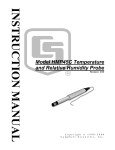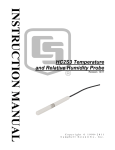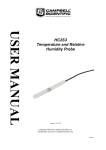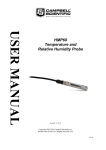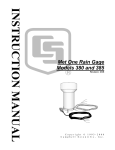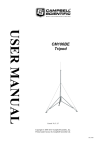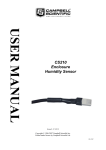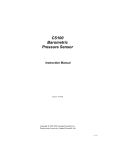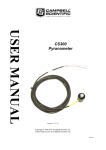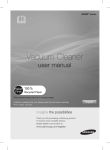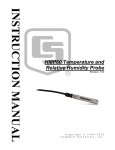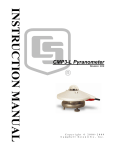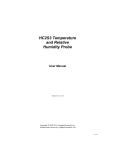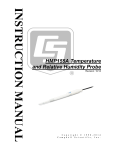Download Campbell HMP45C User guide
Transcript
HMP45C Temperature and Relative Humidity Probe User Guide Issued 27.5.09 Copyright © 1990-2009 Campbell Scientific Inc. Printed under Licence by Campbell Scientific Ltd. CSL 373 Guarantee This equipment is guaranteed against defects in materials and workmanship. This guarantee applies for twelve months from date of delivery. We will repair or replace products which prove to be defective during the guarantee period provided they are returned to us prepaid. The guarantee will not apply to: • Equipment which has been modified or altered in any way without the written permission of Campbell Scientific • Batteries • Any product which has been subjected to misuse, neglect, acts of God or damage in transit. Campbell Scientific will return guaranteed equipment by surface carrier prepaid. Campbell Scientific will not reimburse the claimant for costs incurred in removing and/or reinstalling equipment. This guarantee and the Company’s obligation thereunder is in lieu of all other guarantees, expressed or implied, including those of suitability and fitness for a particular purpose. Campbell Scientific is not liable for consequential damage. Please inform us before returning equipment and obtain a Repair Reference Number whether the repair is under guarantee or not. Please state the faults as clearly as possible, and if the product is out of the guarantee period it should be accompanied by a purchase order. Quotations for repairs can be given on request. When returning equipment, the Repair Reference Number must be clearly marked on the outside of the package. Note that goods sent air freight are subject to Customs clearance fees which Campbell Scientific will charge to customers. In many cases, these charges are greater than the cost of the repair. Campbell Scientific Ltd, Campbell Park, 80 Hathern Road, Shepshed, Loughborough, LE12 9GX, UK Tel: +44 (0) 1509 601141 Fax: +44 (0) 1509 601091 Email: [email protected] www.campbellsci.co.uk PLEASE READ FIRST About this manual Please note that this manual was originally produced by Campbell Scientific Inc. primarily for the North American market. Some spellings, weights and measures may reflect this origin. Some useful conversion factors: Area: Length: 1 in2 (square inch) = 645 mm2 1 in. (inch) = 25.4 mm 1 ft (foot) = 304.8 mm 1 yard = 0.914 m 1 mile = 1.609 km Mass: 1 oz. (ounce) = 28.35 g 1 lb (pound weight) = 0.454 kg Pressure: 1 psi (lb/in2) = 68.95 mb Volume: 1 UK pint = 568.3 ml 1 UK gallon = 4.546 litres 1 US gallon = 3.785 litres In addition, while most of the information in the manual is correct for all countries, certain information is specific to the North American market and so may not be applicable to European users. Differences include the U.S standard external power supply details where some information (for example the AC transformer input voltage) will not be applicable for British/European use. Please note, however, that when a power supply adapter is ordered it will be suitable for use in your country. Some brackets, shields and enclosure options, including wiring, are not sold as standard items in the European market; in some cases alternatives are offered. Details of the alternatives will be covered in separate manuals. Recycling information At the end of this product’s life it should not be put in commercial or domestic refuse but sent for recycling. Any batteries contained within the product or used during the products life should be removed from the product and also be sent to an appropriate recycling facility. Campbell Scientific Ltd can advise on the recycling of the equipment and in some cases arrange collection and the correct disposal of it, although charges may apply for some items or territories. For further advice or support, please contact Campbell Scientific Ltd, or your local agent. Campbell Scientific Ltd, Campbell Park, 80 Hathern Road, Shepshed, Loughborough, LE12 9GX, UK Tel: +44 (0) 1509 601141 Fax: +44 (0) 1509 601091 Email: [email protected] www.campbellsci.co.uk Contents PDF viewers note: These page numbers refer to the printed version of this document. Use the Adobe Acrobat® bookmarks tab for links to specific sections. 1. General Description .................................................... 1 2. Specifications .............................................................. 1 2.1 Temperature Sensor ..................................................................................2 2.2 Relative Humidity Sensor.........................................................................2 3. Installation.................................................................... 2 3.1 Specific instructions for the URS1 Radiation Shield................................3 4. Wiring ........................................................................... 5 5. Example Programs ...................................................... 7 6. Long Lead Lengths ................................................... 10 7. Absolute Humidity..................................................... 12 8. Maintenance............................................................... 15 9. References ................................................................. 16 Appendix A. Wiring for Older HMP45C Probes .......................... A-1 Figures 1. HMP45C and 41003-5 Radiation Shield on a Tripod Mast........................3 2. Inserting the Probe into the Radiation Shield .............................................4 3. HMP45C Probe to Datalogger Connections...............................................5 A-1. HMP45C Probe to Datalogger Connections...................................... A-1 i Tables 1. Connections for Single-Ended Measurements............................................6 2. Connections for Differential Measurements...............................................6 3. Power Connections using PSW12 Peripherals ...........................................7 4. Calibration for Temperature .......................................................................7 5. Calibration for Relative Humidity ..............................................................7 6. Wiring for Single-ended Measurement Examples......................................8 7. Wiring for Differential Measurement Examples ......................................10 8. Wiring for Vapour Pressure Examples.....................................................13 9. Chemical Tolerances of HMP45C............................................................16 A-1. Connections for Single-Ended Measurements for Old Wiring Configuration.................................................................................A-1 A-2. Connections for Differential Measurements for Old Wiring Configurations ...............................................................................A-1 ii HMP45C Temperature and Relative Humidity Probe 1. General Description The HMP45C Temperature and Relative Humidity probe contains a Platinum Resistance Temperature detector (PRT) and a Vaisala HUMICAP® 180 capacitive relative humidity sensor. The HMP45C can be powered continuously or the power may be switched to conserve battery life. The HMP45C consumes less than 4 milliamperes current at 12 volts. Approximately 0.15 seconds is required for the sensor to warm up after power is switched on. At measurement rates slower than once per second, the overall power consumption (datalogger and sensors) may be reduced by switching power to the HMP45C. Most current Campbell Scientific dataloggers have a built-in switched 12 volts that can be used to control power. The CR9000, CR510, CR500, CR7, CR10 and 21X dataloggers do not have a built-in switched 12 volts. Users with these dataloggers can power the sensor continuously or purchase the model PSW12 to switch power. 2. Specifications Operating Temperature: -40°C to +60°C Storage Temperature: -40°C to +80°C Probe Length: 25.4 cm (10 in.) Probe Body Diameter: 2.5 cm (1 in.) Filter: 0.2 μm Teflon membrane Filter Diameter: 1.9 cm (0.75 in.) Power Consumption: <4 mA @ 12 V Supply Voltage: 7 to 35 VDC Settling Time: 0.15 seconds The HMP45C ships with: (1) Adjustment Screwdriver from mfg (1) Calibration Sheet (1) Instruction Manual 1 HMP45C Temperature and RH Probe 2.1 Temperature Sensor Sensor: 1000 Ω PRT, IEC 751 1/3 Class B Temperature Measurement Range: -40°C to +60°C Temperature Output Signal range: 0.008 to 1.0 V Temperature Accuracy: Error ( o C) 0.4 0.2 0.0 -0.2 -0.4 -40 -20 0 20 40 60 o Temperature ( C) 2.2 Relative Humidity Sensor Sensor: HUMICAP® 180 Relative Humidity Measurement Range: 0 to 100% non-condensing RH Output Signal Range: 0.008 to 1 VDC Accuracy at 20°C ±2% RH (0 to 90% Relative Humidity) ±3% RH (90 to 100% Relative Humidity) Temperature Dependence of Relative Humidity Measurement: ±0.05% RH/°C Typical Long Term Stability: Better than 1% RH per year Response Time (at 20°C, 90% response): 15 seconds with membrane filter 3. Installation The HMP45C must be housed inside a radiation shield when used in the field. The MET21, URS1 (Figure 1) or 41003-5 Radiation Shield (Figure 1 and 2) mounts to a tripod mast, UT930 ATW tower leg. A standard lead length of 3 m allows the HMP45C to be mounted at a 2 or 3 m height on a tripod mast or tower leg. NOTE The black outer jacket of the cable is Santoprene® rubber. This compound was chosen for its resistance to temperature extremes, moisture, and UV degradation. However, this jacket will support combustion in air. It is rated as slow burning when tested according to U.L. 94 H.B. and will pass FMVSS302. Local fire codes may preclude its use inside buildings. With the exception of the URS1 (see below) the probe should be installed so the tip of the probe is positioned in the middle of the shield, relative to top and bottom plates of the shield. 2 User Guide CAUTION Do not overtighten the nut that holds in the probe as the probe could be damaged. Figure 1. HMP45C and 41003-5 Radiation Shield on a Tripod Mast 3.1 Specific instructions for the URS1 Radiation Shield A typical radiation shield for the HMP45C is shown in Figure 1. This shield, as sold by Campbell Scientific, is supplied with an adapter that enables the HMP45C to be fitted and detached as follows: 1. Loosen the large retaining nut at the bottom of the shield until it turns freely. 2. Gently insert the HMP45C through the centre of the nut. 3. During insertion, observe the probe by looking through the radiation shield between the lowest curved plate and the flat white disc at the bottom of the housing – see Figure 2. The tip of the probe will pass through a hole in a white rubber sealing membrane that is mounted on the upper surface of the flat white disc. 4. Continue to carefully insert the probe until the larger section of the probe body (the ‘handle’) emerges through the sealing membrane – see Figure 2 (a). 3 HMP45C Temperature and RH Probe 5. Continue to carefully insert the probe a further 10mm, until the shoulder of the larger section is approximately level with the hole in the lowest curved disc, as shown in Figure 2 (b), below. 6. Tighten the large retaining nut by hand (do not use any tools) until the probe is firmly gripped. If the probe does not appear to be sitting squarely inside the shield, loosen the nut, re-position the probe and re-tighten. DO NOT PULL THE PROBE DOWNWARDS PRIOR TO TIGHTENING THE NUT, as this will also pull the sealing membrane downwards producing a water trap. (See CAUTION below.) 7. Finally, bend the cable in a gentle loop back up towards the mounting arm and attach it to the arm with the cable ties supplied. (a) Larger section of probe body in final position (level with lip of first curved disc) and showing the sealing membrane on the flat disc in the correct position. Flat white disc. Observe here Carefully push the HMP45C up into the radiation shield. Sealing membrane must curve upwards to repel water. Figure 2 Inserting the Probe into the Radiation Shield 4 (b) User Guide CAUTION 1. Do not push the probe so far into the radiation shield that the sensor tip touches the top of the shield. 2. Ensure that your last action before tightening the large securing nut is not to withdraw the probe (i.e. do not pull in a downwards direction). This will cause the sealing membrane to also pull downwards and will form a well around the sensor which may then trap water. The sealing membrane must curve UPWARDS towards the tip of the sensor to encourage any water to run away from the sensor body – see Figure 2. 3. Do not over-tighten the nut, as it is possible to crush the sensor if too much force is used. 4. Always use the cable ties provided to attach the cable to the mounting arm to prevent cable movement in the wind, which could cause the wire to break. In dirty environments, clean the radiation shield every month. 4. Wiring Connections to Campbell Scientific dataloggers are given in Tables 1 through 3. The probe can be measured by two single-ended or differential analogue input channels. CAUTION When measuring the HMP45C with single-ended measurements, the blue and black leads must both be connected to AG on the CR10(X) and CR500/CR510 or to on the CR800/850, CR1000, CR5000, and CR23X. Doing otherwise will connect the datalogger’s analogue and power ground planes to each other, which in some cases can cause offsets on low-level analogue measurements. To avoid 4 mA flowing into analogue ground, switch the sensor on/off for its own measurement. Description Temperature Signal Relative Humidity Signal Signal Reference Power Power Ground Screen/Shield Colour White Green Blue Red Black Shield NOTE: These wire colours differ from HMP45C probes supplied in the USA. Figure 3. HMP45C Probe to Datalogger Connections 5 HMP45C Temperature and RH Probe Table 1. Connections for Single-Ended Measurements Sensor Connection Temperature Signal Relative Humidity Signal Signal Reference Power Ground Shield Power Continuous/Switched CR10X Power Control if using SW12V channel on datalogger Colour White CR10X Single-Ended Input Single-Ended Input AG AG G SW12V Green Blue Black Shield Red CR1000, CR3000, CR800, CR5000, CR23X Single-Ended Input Single-Ended Input SW12 CR10, CR510, CR500 Single-Ended Input Single-Ended Input AG AG G 12V/PSW12* 21X, CR7 Single-Ended Input Single-Ended Input 12V/PSW12* Jumper from SW12V Control to Control Port *On these dataloggers switched power is only available with the PSW12 peripheral. Table 2. Connections for Differential Measurements Sensor Connection Temperature Signal Temperature Signal Reference Relative Humidity Signal Jumper to Blue Green Signal Reference Blue Power Ground Shield Power Continuous/Switched CR10X Power Control if using SW12V channel on datalogger Black Shield Red Colour White CR10X Differential Input – H Differential Input – L Differential Input – H Differential Input – L G G 12V/SW12V CR1000, CR3000, CR800, CR5000, CR23X Differential Input – H Differential Input – L Differential Input – H Differential Input – L G 12V/SW12 CR10, CR510, CR500 Differential Input – H Differential Input – L Differential Input – H Differential Input – L G G 12V/PSW12* Jumper from SW12V Control to Control Port *On these dataloggers switched power is only available with the PSW12 peripheral. NOTE: These wire colours differ from HMP45C probes supplied in the USA. 6 21X, CR7 Differential Input – H Differential Input – L Differential Input – H Differential Input – L 12V/PSW12* User Guide Table 3. Power Connections using PSW12 Peripherals HMP45C Description Colour PSW12 Peripheral Terminal Wire Datalogger Power Red 12V Red 12V Power Ground Black G Black* See tables 1&2 Control Port Yellow *The black wire of the PSW12 should be connected to the type of datalogger ground channel recommended for the HMP45C black wire as listed in Table 1 and 2. 5. Example Programs This section is for users who write their own datalogger programs. A datalogger program to measure this sensor can be created using Campbell Scientific’s Short Cut Program Builder software. You do not need to read this section to use Short Cut. The temperature and relative humidity signals from the HMP45C can be measured using a single-ended analogue measurement or a differential analogue measurement. Use a single-ended analogue measurement when the HMP45C signal lead length is less than 6.1 m (20 ft.) or if the probe will be turned on and off under datalogger control between measurements. For lead lengths greater than 6.1 m (20 ft.) or when the probe will be continuously powered, use a differential analogue measurement. For a discussion on errors caused by long lead lengths see Section 6. The HMP45C output scale is 0 to 1000 millivolts for the temperature range of -40°C to +60°C and for the relative humidity range of 0 to 100%. Tables 4 and 5 provide calibration information for temperature and relative humidity. Table 4. Calibration for Temperature Units Celsius Fahrenheit Multiplier (degrees mV-1) 0.1 0.18 Offset (degrees) -40 -40 Table 5. Calibration for Relative Humidity Units Percent Fraction Multiplier (% mV-1) 0.1 0.001 Offset (%) 0 0 7 HMP45C Temperature and RH Probe Table 6. Wiring for Single-ended Measurement Examples Description Temperature Relative Humidity Signal Reference Jumper from SW12V Control Power Power Ground Shield Colour White Green Blue CR1000 SE 2 (1L) SE 1 (1H) N/A Red Black Clear SW12 V CR10(X) SE 3 (2H) SE 4 (2L) AG C1 SW12 V AG G NOTE: These wire colours differ from HMP45C probes supplied in the USA. CR1000 Program using Single-Ended Measurement Instructions Using SW12 on Datalogger 'CR1000 program to measure HMP45C with single-ended measurements Public AirTC Public RH DataTable(Temp_RH,True,-1) DataInterval(0,60,Min,0) Average(1,AirTC,IEEE4,0) Sample(1,RH,IEEE4) EndTable BeginProg Scan(1,Sec,1,0) 'HMP45C Temperature & Relative Humidity Sensor measurements AirTC and RH: SW12 (1 ) Delay(0,150,mSec) VoltSE(AirTC,1,mV2500,2,0,0,_50Hz,0.1,-40.0) VoltSE(RH,1,mV2500,1,0,0,_50Hz,0.1,0) SW12 (0) If RH>100 And RH<108 Then RH=100 CallTable(Temp_RH) NextScan EndProg 8 User Guide CR10(X) Program using Single-Ended Measurement Instructions Using a PSW12 or SW12V on Datalogger ;Turn the HMP45C on. ; 01: Do (P86) 1: 41 Set Port 1 High ;Jumper wire from PSW12 control to C1 ;Yellow wire (C1) if using PSW12 device ;For CR23X or CR5000 use 49 for SW12V internal ;control port ;Pause 150 mSec before making measurements so the ;probe can stabilize on true readings. ; 02: Excitation with Delay (P22) 1: 1 Ex Channel 2: 0 Delay W/Ex (units = 0.01 sec) 3: 15 Delay After Ex (units = 0.01 sec) 4: 0 mV Excitation ;Measure the HMP45C temperature. ; 03: Volt (SE) (P1) 1: 1 Reps 2: 5 2500 mV Slow Range 3: 4: 5: 6: 3 1 .1 -40 SE Channel Loc [ T_C Mult Offset ] ;See Table 4 for alternative multipliers ;See Table 4 for alternative offsets ;Measure the HMP45C relative humidity. ; 04: Volt (SE) (P1) 1: 1 Reps 2: 5 2500 mV Slow Range 3: 4: 5: 6: 4 2 .1 0 ;CR510, CR500 (2500mv); CR23X (1000 mV); 21X, CR7 (5000 mV) SE Channel Loc [ RH_pct Mult Offset ;CR510, CR500 (2500 mV); CR23X (1000 mV); 21X, CR7 (5000 mV) ] ;See Table 5 for alternative multipliers ;Turn the HMP45C off. ; 05: Do (P86) 1: 51 Set Port 1 Low 9 HMP45C Temperature and RH Probe 6. Long Lead Lengths This section describes the error associated with measuring the HMP45C with a single-ended measurement if the probe has a long cable. To avoid these problems, CSI recommends measuring the HMP45C using a differential analogue measurement (Instruction 2) when long lead lengths are required. Generic datalogger connections for measuring the HMP45C using a differential measurement are given in Table A-2. Understanding the details in this section are not required for the general operation of the HMP45C with Campbell Scientific’s dataloggers. The signal reference (blue) and the power ground (black) are in common inside the HMP45C. When the HMP45C temperature and relative humidity are measured using a single-ended analogue measurement, both the signal reference and power ground are connected to ground at the datalogger. The signal reference and power ground both serve as the return path for 12 V. There will be a voltage drop along those leads because the wire itself has resistance. The HMP45C draws approximately 4 mA when it is powered. The wire used in the HMP45C (P/N 9721) has resistance of 27.7 Ω/1000 feet. Since the signal reference and the power ground are both connected to ground at the datalogger, the effective resistance of those wires together is half of 27.7 Ω/1000 feet, or 13.9 Ω/1000 feet. Using Ohm’s law, the voltage drop (Vd), along the signal reference/power ground, is given by Eq. (1). Vd = I ∗R = 4 mA ∗ 13.9 Ω 1000 ft (1) = 55.6 mV 1000 ft This voltage drop will raise the apparent temperature and relative humidity because the difference between the signal and signal reference lead, at the datalogger, has increased by Vd. The approximate error in temperature and relative humidity is 0.56°C and 0.56% per 100 feet of cable length, respectively. Table 7. Wiring for Differential Measurement Examples Description Temperature Jumper to 1L Relative Humidity Signal Reference Jumper from SW12V Control Power Power Ground Shield Colour White Green Blue Red Black Clear CR10(X) 2H 2L 1H 1L C1 SW12 V G G CR1000 2H 2L 1H 1L N/A SW12 V G NOTE: These wire colours differ from HMP45C probes supplied in the USA. 10 User Guide CR1000 Program using Differential Measurement Instructions Using SW12 on Datalogger 'CR1000 program to measure HMP45C with differential measurements Public AirTC Public RH DataTable(Temp_RH,True,-1) DataInterval(0,60,Min,0) Average(1,AirTC,IEEE4,0) Sample(1,RH,IEEE4) EndTable BeginProg Scan(1,Sec,1,0) 'HMP45C Temperature & Relative Humidity Sensor measurements AirTC and RH: SW12 (1 ) Delay(0,150,mSec) VoltDiff (AirTC,1,mV2500,2,True,0,_50Hz,0.1,-40) VoltDiff (RH,1,mV2500,1,True,0,_50Hz,0.1,0) SW12 (0) If RH>100 And RH<108 Then RH=100 CallTable(Temp_RH) NextScan EndProg CR10(X) Program using Differential Measurement Instructions Using SW12V on Datalogger ;Turn the HMP45C on. ; 01: Do (P86) 1: 41 Set Port 1 High ;Jumper wire from SW12V control to C1 ;Yellow wire (C1) if using PSW12 device ;For CR23X or CR5000 use 49 for SW12V internal ;control port ;Pause 150 mSec before making measurements so the ;probe can stabilize on true readings. ; 02: Excitation with Delay (P22) 1: 1 Ex Channel 2: 0 Delay W/Ex (units = 0.01 sec) 3: 15 Delay After Ex (units = 0.01 sec) 4: 0 mV Excitation 11 HMP45C Temperature and RH Probe ;Measure the HMP45C temperature. ; 03: Volt (Diff) (P2) 1: 1 Reps 2: 5 2500 mV Slow Range 3: 4: 5: 6: 2 1 .1 -40 DIFF Channel Loc [ T_C ] Mult Offset ;Measure the HMP45C relative humidity. ; 04: Volt (Diff) (P2) 1: 1 Reps 2: 5 2500 mV Slow Range 3: 4: 5: 6: 1 2 .1 0 DIFF Channel Loc [ RH_pct ] Mult Offset ;CR510, CR500 (2500mv); CR23X (1000 mV); 21X, CR7 (5000 mV) ;See Table 4 for alternative multipliers ;See Table 4 for alternative offsets ;CR510, CR500 (2500mv); CR23X (1000 mV); 21X, CR7 (5000 mV) ;See Table 5 for alternative multipliers ;Turn the HMP45C off. ; 05: Do (P86) 1: 51 Set Port 1 Low 7. Absolute Humidity The HMP45C measures the relative humidity. Relative humidity is defined by the equation below: RH = e ∗ 100 es (2) where RH is the relative humidity, e is the vapour pressure in kPa , and es is the saturation vapour pressure in kPa. The vapour pressure, e, is an absolute measure of the amount of water vapour in the air and is related to the dew point temperature. The saturation vapour pressure is the maximum amount of water vapour that air can hold at a given air temperature. The relationship between dew point and vapour pressure, and air temperature and saturation vapour pressure are given by Goff and Gratch (1946), Lowe (1977), and Weiss (1977). When the air temperature increases, so does the saturation vapour pressure. Conversely, a decrease in air temperature causes a corresponding decrease in saturation vapour pressure. It follows then from Eq. (2) that a change in air temperature will change the relative humidity, without causing a change in absolute humidity. For example, for an air temperature of 20°C and a vapour pressure of 1.17 kPa, the saturation vapour pressure is 2.34 kPa and the relative humidity is 50%. If the air temperature is increased by 5°C and no moisture is added or removed from the air, the saturation vapour pressure increases to 3.17 kPa and the relative humidity decreases to 36.9%. After the increase in air temperature, there is more energy to vaporise the water. However, the actual amount of water vapour 12 User Guide in the air has not changed. Thus, the amount of water vapour in the air, relative to saturation, has decreased. Because of the inverse relationship between relative humidity and air temperature, finding the mean relative humidity is meaningless. A more useful quantity is the mean vapour pressure. The mean vapour pressure can be computed on-line by the datalogger (Example 3). Table 8. Wiring for Vapour Pressure Examples Description Temperature Relative Humidity Signal Reference Jumper from SW12V Control Power Power Ground Shield Colour White Green Blue CR1000 SE 2 (1L) SE 1 (1H) N/A Red Black Clear SW12 V CR10(X) SE 3 (2H) SE 4 (2L) AG C1 SW12 V AG G NOTE: These wire colours differ from HMP45C probes supplied in the USA. CR1000 Program that Computes Vapour Pressure and Saturation Vapour Pressure 'CR1000 program that calculates Vapour Pressure Public AirTC Public RH Public RH_Frac, e_Sat, e_kPa DataTable(Temp_RH,True,-1) DataInterval(0,60,Min,0) Average(1,AirTC,IEEE4,0) Sample(1,RH,IEEE4) Sample(1,e_kPa,IEEE4) EndTable BeginProg Scan(1,Sec,1,0) 'HMP45C Temperature & Relative Humidity Sensor measurements AirTC and RH: SW12 (1 ) Delay(0,150,mSec) VoltSE(AirTC,1,mV2500,2,0,0,_50Hz,0.1,-40.0) VoltSE(RH,1,mV2500,1,0,0,_50Hz,0.1,0) SW12 (0) If RH>100 And RH<108 Then RH=100 'Calculate Vapour Pressure 'Convert RH percent to RH Fraction RH_Frac = RH * 0.01 'Calculate Saturation Vapour Pressure SatVP(e_Sat, AirTC) 'Compute Vapour Pressure, RH must be a fraction e_kPa = e_Sat * RH_Frac CallTable(Temp_RH) NextScan EndProg 13 HMP45C Temperature and RH Probe CR10(X) Program that Computes Vapour Pressure and Saturation Vapour Pressure ;Turn the HMP45C on. ; 01: Do (P86) 1: 41 Set Port 1 High ;Jumper wire from SW12V control to C1 ;Yellow wire (C1) if using PSW12 device ;For CR23X or CR5000 use 49 for SW12V internal ;control port ;Pause 150 mSec before making measurements so the ;probe can stabilize on true readings. ; 02: Excitation with Delay (P22) 1: 1 Ex Channel 2: 0 Delay W/Ex (units = 0.01 sec) 3: 15 Delay After Ex (units = 0.01 sec) 4: 0 mV Excitation ;Measure the HMP45C temperature. ; 03: Volt (SE) (P1) 1: 1 Reps 2: 5 2500 mV Slow Range 3: 4: 5: 6: 3 1 .1 -40 SE Channel Loc [ T_C Mult Offset ] ;Measure the HMP45C relative humidity. ; 04: Volt (SE) (P1) 1: 1 Reps 2: 5 2500 mV Slow Range 3: 4: 5: 6: 14 4 2 .001 0 ;CR510, CR500 (2500mv); CR23X (1000 mV); 21X, CR7 (5000 mV) SE Channel Loc [ RH_frac ] Mult Offset ;CR510, CR500 (2500mv); CR23X (1000 mV); 21X, CR7 (5000 mV) User Guide ;Turn the HMP45C off. ; 05: Do (P86) 1: 51 Set Port 1 Low ;Compute the saturation vapour pressure. ;The temperature must be in degrees Celsius. ; 06: Saturation Vapour Pressure (P56) 1: 1 Temperature Loc [ T_C 2: 3 Loc [ e_sat ] ] ;Compute the vapour pressure. ;Relative humidity must be a fraction. ; 07: Z=X*Y (P36) 1: 3 X Loc [ e_sat ] 2: 2 Y Loc [ RH_frac ] 3: 4 Z Loc [ e ] 8. Maintenance The HMP45C Probe requires minimal maintenance. Check monthly to make sure the radiation shield is free from debris. The black screen at the end of the sensor should also be checked for contaminates. When installed in close proximity to the ocean or other bodies of salt water (e.g., Great Salt Lake), a coating of salt (mostly NaCl) may build up on the radiation shield, sensor, filter and even the chip. NaCl has an affinity for water. The humidity over a saturated NaCl solution is 75%. A buildup of salt on the filter or chip will delay or destroy the response to atmospheric humidity. The filter can be rinsed gently in distilled water. If necessary, the chip can be removed and rinsed as well. Do not scratch the chip while cleaning. Long term exposure of the HUMICAP® relative humidity sensor to certain chemicals and gases may affect the characteristics of the sensor and shorten its life. Table 9 lists the maximum ambient concentrations, of some chemicals, that the HUMICAP® can be exposed to. Table 9. Chemical Tolerances of HMP45C Chemical Organic solvents Aggressive chemicals (e.g. SO2, H2SO4, H2S, HCl, Cl2, etc.) Weak Acids Bases Concentration (PPM) 1000 to 10,000 1 to 10 100 to 1000 10,000 to 100,000 Recalibrate the HMP45C annually. Obtain a returns number before returning the HMP45C to Campbell Scientific for recalibration. 15 HMP45C Temperature and RH Probe 9. Troubleshooting Symptom: -9999, NAN, -40 deg C, or 0% relative humidity 1. Check that the sensor is wired to the correct excitation and analogue input channels as specified by the measurement instructions. 2. Verify the Range code is correct for the datalogger type. 3. Verify the red power wire is correctly wired to the 12V, Switched 12V, or PSW12 module. The terminal the wire is connected to will depend on the datalogger program. Connect the red wire to a 12V terminal to constantly power the sensor for troubleshooting purposes. With the red wire connected to 12V, a voltmeter can be used to check the output voltage for temperature and relative humidity on the yellow and blue wires respectively (temperature °C = mV *0.1 – 40.0; relative humidity % = mV * 0.1). Symptom: Incorrect temperature or relative humidity. 1. Verify the multiplier and offset parameters are correct for the desired units (Table 5-1). 10. References Goff, J. A. and S. Gratch, 1946: Low-pressure properties of water from -160° to 212°F, Trans. Amer. Soc. Heat. Vent. Eng., 51, 125-164. Lowe, P. R., 1977: An approximating polynomial for the computation of saturation vapour pressure, J. Appl. Meteor., 16, 100-103. Weiss, A., 1977: Algorithms for the calculation of moist air properties on a hand calculator, Amer. Soc. Ag. Eng., 20, 1133-1136. 16 Appendix A. Wiring for Older HMP45C Probes Description Temperature Signal Relative Humidity Signal Signal Reference Power Control Power Power Ground Shield Colour Yellow Blue Purple Orange Red Black Shield Figure A-1. HMP45C Probe to Datalogger Connections Table A-1. Connections for Single-Ended Measurements for Old Wiring Configuration Description Colour Temperature Relative Humidity Signal Reference Power Control Power Power Ground Shield Yellow Blue Purple Orange Red Black Clear CR10(X), CR510, CR500 Single-Ended Input Single-Ended Input AG Control Port 12 V G G CR23X, CR5000 21X, CR7 Single-Ended Input Single-Ended Input Single-Ended Input Single-Ended Input Control Port 12 V G Control Port 12 V Table A-2. Connections for Differential Measurements for Old Wiring Configurations Description Colour Temperature Signal Reference Yellow Jumper to Purple Blue Purple Orange Red Black Clear Relative Humidity Signal Reference Power Control Power Power Ground Shield CR10(X), CR510, CR500 Differential Input (H) Differential Input (L) Differential Input (H) Differential Input (L) Control Port 12 V G G This is a blank page. CR23X, CR5000 21X, CR7 Differential Input (H) Differential Input (L) Differential Input (H) Differential Input (L) Differential Input (H) Differential Input (L) Control Port 12 V G Differential Input (H) Differential Input (L) Control Port 12 V A-1 CAMPBELL SCIENTIFIC COMPANIES Campbell Scientific, Inc. (CSI) 815 West 1800 North Logan, Utah 84321 UNITED STATES www.campbellsci.com [email protected] Campbell Scientific Africa Pty. Ltd. (CSAf) PO Box 2450 Somerset West 7129 SOUTH AFRICA www.csafrica.co.za [email protected] Campbell Scientific Australia Pty. Ltd. (CSA) PO Box 444 Thuringowa Central QLD 4812 AUSTRALIA www.campbellsci.com.au [email protected] Campbell Scientific do Brazil Ltda. (CSB) Rua Luisa Crapsi Orsi, 15 Butantã CEP: 005543-000 São Paulo SP BRAZIL www.campbellsci.com.br [email protected] Campbell Scientific Canada Corp. (CSC) 11564 - 149th Street NW Edmonton, Alberta T5M 1W7 CANADA www.campbellsci.ca [email protected] Campbell Scientific Ltd. (CSL) Campbell Park 80 Hathern Road Shepshed, Loughborough LE12 9GX UNITED KINGDOM www.campbellsci.co.uk [email protected] Campbell Scientific Ltd. (France) Miniparc du Verger - Bat. H 1, rue de Terre Neuve - Les Ulis 91967 COURTABOEUF CEDEX FRANCE www.campbellsci.fr [email protected] Campbell Scientific Spain, S. L. Psg. Font 14, local 8 08013 Barcelona SPAIN www.campbellsci.es [email protected] Campbell Scientific Ltd. (Germany) Fahrenheitstrasse13, D-28359 Bremen GERMANY www.campbellsci.de [email protected] Please visit www.campbellsci.com to obtain contact information for your local US or International representative.




























